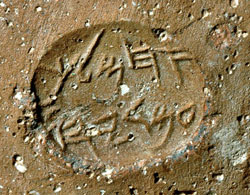State seal impressions were discovered in the excavation of the Antiquities Authority in Umm Tova in the south of the Jerusalem mountains

In a salvage excavation conducted by Zubair Adoyi on behalf of the Antiquities Authority in the village of Umm Tova in southern Jerusalem (between Tzur Bahar and the Har Huma neighborhood), before construction work by a private entrepreneur, a large building from the First and Second Temple periods was discovered with a surprising wealth of inscriptions.
Considering the limited area of the excavation and the rural nature of the structure that was uncovered, the diggers were surprised to discover one after another royal seal impressions from the time of King Hezekiah of Judah (late eighth century BC). Four prints of the type known as "King's Seals" were discovered on the handles of large jugs intended for storing wine and oil in state administrative centers, and with them were also discovered seal impressions of two high-ranking officials in the kingdom's administrative system. The name of one is "Achimelech ben Amadiyo" and the other is "Yehohil ben Shachar". Yehuhil's seal imprint was imprinted on top of one of the "King" imprints, before the jug was fired in the kiln, and this is one of the very rare cases where two such imprints appear together on one handle.
Another Hebrew inscription, 600 years later than the seal impressions of the Kingdom of Judah, was discovered on a fragment of a jug neck from the Hasmonean period. With a thin iron chisel, the letters Alef Beit Kasdaran were carved under the rim of the vessel, in the Jewish script typical of the beginning of the Hasmonean period (late second century BC). In the fragment, the letters XNUMX to XNUMX and a small fragment of the letter XNUMX survived. Similar inscriptions of the sequence of letters of the thousand syllables were usually discovered in the past in ostracon (inscriptions in ink on pottery shards), or engraved on glosskamas (stone burial boxes). The Alpha-Beta inscription that has just been discovered is unique and its meaning still requires research: was it a "writing exercise" of an apprentice scribe or should it be attributed a magical meaning?
The remains of the large building included several rooms around a courtyard. Pits, agricultural facilities and underground silos were dug in the area of the yard. A kiln for the production of pottery was also discovered inside the built complex; a large columbarium (pigeon trap) cave, from which a hiding hole was carved; Pottery and more. The pottery found in the ruins of the building indicates that it began at the end of the Iron Age (First Temple period), in the eighth century BC. After its destruction with the destruction of Jerusalem and the entire land of Judah during the Babylonian occupation, Jews returned to settle there in the Hasmonean period (second century BC) and it existed for about two hundred years until the destruction of the Second Temple. In the Byzantine period they returned to the place as part of an extensive rural settlement of monasteries and farms in the area between Jerusalem and Bethlehem.
Nearby, about three years ago, impressive remains of a monastery from this period were excavated, which together with the remains from the current excavation confirm the identification of the place as "Metopa" mentioned in the writings of the church fathers from the Byzantine period. The name of the Arab village "Um Tova" is therefore a linguistic incarnation of the Byzantine "Metupa" which is the biblical "Netupa", which is mentioned as the place of origin of two of King David's heroes (Samuel XNUMX, XNUMX: XNUMX-XNUMX).

7 תגובות
to Q
According to Deetz's article:
(A) (H/E) M L K E M (D) J E
What is in brackets are letters that are not clear enough to need a seal.
To a point:
I'm not "someone" 🙂 But you mean using one of the letters AHUI as a reading mother.
It seems that this is a process that started already in the First Temple period.
See:
http://he.wikipedia.org/wiki/%D7%90%D7%9D_%D7%A7%D7%A8%D7%99%D7%90%D7%94
What a poor contractor. Because of a group of people who walked around thousands of years ago now all his livelihood is stuck. As if we don't know that there was an ancient Hebrew kingdom here. Let the living live, let the dead die.
Yaron:
Are you so torn that you did another sex change from Anna to Yossi?
To Michael, wow, how funny you are, I just burst out laughing.
Just as an exercise I liked to do in my youth
I tried to decipher what was written in the seal according to ancient Hebrew writings, Moab, Phoenician, ancient Hebrew and I got really confused;) It seems to me that the person who left the seal (in the accompanying photo) was careless,,;) Either he was an apprentice, or he signed quickly and casually, or a child who practiced, and maybe similar to today It's just hard to be precise manually on clay.
In any case, the names/letters mentioned in the article are not taken from the photograph accompanying the article.
I especially had difficulty with the fifth letter from the right in the top row, and the third letter from the right in the bottom row, and also the two final ones from the left,,(?)
Just a guess:
I don't know but I'm guessing someone does 🙂
Does anyone know when they started using the letters Ahoy as we know them today?